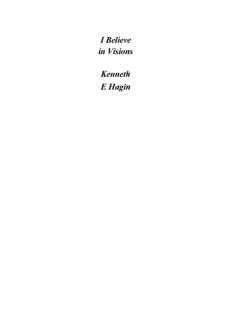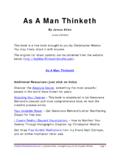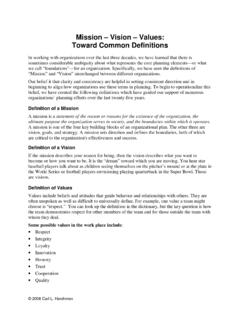Transcription of Tantric Visions of the Divine Feminine - manushi-india.org
1 38 MANUSHIIn the uproar over the patriarchaland male chauvinist prejudicethat is said to infest India sscriptures like a black plague, a basicfact is lost. No other living religioustradition in the world presents sucha continuous and richly diverserecord from prehistoric times ofworshipping the Divine as was in Hindu Goddesses thatDavid Kinsley provided a synopticview of this beginning from theprehistoric Indus civilization and thepristine Vedic theogony, through theitihasa-purana and tantricpantheon, down to the villagedeities. His work inspired severalinvestigations into this neglectedarea by Hawley, Wulff and how to make sense of atradition that worships a hag, or agoddess who chops off her ownhead and directs the spouting bloodinto the mouths of two yoginis andher own; or one who, seated on acorpse, plucks out a demon stongue; another whose terrifyingform has to be worshipped withpolluted offerings in a cremationground; and yet another whostraddles her consort on a funeralpyre?
2 David Kinsley s book TantricVisions of the Divine Feminine (Motilal Banarsidass pp 318) is themost recent study to be publishedin response to this puzzle, and itsparticular importance lies inexamining how the left-handedway conceptualises the intensely individualistic,this form of worship is very differentfrom the Vedic and Puranic sacrificialceremonies that involved thecommunity. This group of goddessespresents a veritable anti-model forwomen, quite the opposite of thedoormat of a housewife. In them thepredominant theme is the oxymoroniccoupling of death and mating, withthe goddess almost invariably nakedand in the dominant ( reverse )position. In some cases even theofferings are of items that aretraditionally branded as sacrifices these goddessesdemand are invariably of malevictims. This curious phenomenon,that this in which conceptualisationis entirely by male devotees, needsdeeper research.
3 Kinsley providesinformation, hitherto unknown, thatthere are female sources on TantricBuddhism which scholars haveignored. Yet another instance ofchauvinistic blindness? None ofthese western scholar have notedthat the earliest hymn devoted to agoddess occurring in the is also the only one composedby a woman: the seer Vak, daughterof rishi Ambhrin This oldest mantrais also the most sublime of allinvocations to the Divine , experiencing the SupremeGoddess, Adi Shakti, as her Selfdeclaims, It is I who, creating theuniverse and all worlds, whollypervade them like the wind. ThoughI transcend the heavens and thisearth, yet by my glory have Imanifested creation. It is preciselythis sublimity that one seeks for inthe Tantric vision and is left baffledand bewildered by the deliberatepiling up of horror upon horror.
4 Theessence of the left-handed path isachieving transcendence throughplumbing the depths of the , this group of ten spansthe spectrum from the horripilatinglydreadful to the sublimely benignexemplified with its celebration ofChinnamasta at one end and Kamalaat the other. One could, perhaps, arguefor a gradual progression towards thelatter end and even a successiveattenuation of the horrifying concept of Kamala comes as thelast, after Tripura-sundari, the beautyof the three worlds is celebrated inthe Lalita Sahasranama, whosesymbol is the Shri Chakra,Bhuvaneshvari and whose body isBOOK DISCUSSIONT antric Visions of the Divine Feminine by David Kinsley Review : Pradip BhattacharyaHow to make sense of atradition that worships ahag, or a goddess whochops off her own headand directs the spoutingblood into the mouths oftwo yoginis and her earliest hymndevoted to a goddessoccurring in the Rigvedais also the only onecomposed by a Despite being a widow,the hymn invokingDhumavati makes herthe creatrix of dance andenjoyer of erotic activityand author is a Kolkatta IAS world symbolised by the invertedtriangle and Matangi, the outcaste,who insists upon being worshippedwith offerings of leftover food.
5 Thesethree are represented as lovelysixteen year old maidens, the lattertwo appearing without any consortwhile Lalita appears seated upon areclining Shiva. Similarly, the otherMahaVidyas are quite independentof him and indeed their verymanifestations are in defiance of , of course, appears as awidow, consort-less, originating, likeBagalamukhi, in Sati swallowingShiva when he would not assuageher hunger. However, the purposebehind worshipping this formremains quite obscure. Despite beinga widow, the hymn invoking hermakes her the creatrix of dance andenjoyer of erotic activity and s research reveals animportant fact that each MahaVidyais a facet of the multifaceted GreatGoddess, each containing all theothers. This is revealed in theinvocatory versus addressed to anyof them which usually ascribe to herthe names of many of the other does not, however, take intoaccount the very different versionfound in the Devi Purana Shiva invokes the SupremeShakti of eight Vidyas to destroySubal and Dundubhi at the requestof Vishnu and the gods.
6 Knowingweapons will be ineffectual, shediscards her youthful form andbecomes over a hundred years oldwith withered skin, networked withveins, and with sunken eyes. She haspale lips, gaping mouth-cavern, limbsa-tremble, a snake on the head, herleft hand on the left thigh, the righthand on her back, encircled by eightVidyas astride ox, lion, elephant,peacock, garuda, bear, black-spotteddeer respectively. These Vidyas dwellspecially with women in the innerapartments as clan-deities. To thepulinda and shabara tribes they givesiddhi in the left handed way. Theyare established with prostitutes,gopis, tribals (Hun, Khas, Turani,Kol) and in Hastinapur, Ujjaini,Kamakshya, Kishkindhya, Bhotcountry, Koshala, Raadh, Mahodaya,Varendra land, Vidisha, crone obstructs the DanavaSharabh s way, telling him to lie withher and not discard her as old.
7 Themoment he holds her hand to lift herup, he falls version in this Purananarrates that after Parashuramabrought Kalika from Yashoda besidethe northern sea and established herin Ayodhya, nine Durgas emergedfrom her and were established inMahodaya. Chapter 150 of DeviPurana speaks of her form asVaivasvati, riding a buffalo, with boar-like face, drinking from a skull andholding a staff. As Aghora, she has aterrifying face, clad in lion and deerskin, wearing a necklace of heads withskull and pike in hand. As Karali ofthe terrible face, her hair is put up,she wears a necklace of skulls, hermouth is full of meat and she delightsin black coloured offerings. As Vikatashe rides a camel, holds noose andstaff in huge hands, sports aterrifying mein, has black sandal pastesmeared on her body, is surroundedby scorpions and cockroaches,delights in fish, fat and bloody , the ten MahaVidyas are by nomeans unique.
8 Their multiforms existin the nine Durgas, the eight Vidyas,and the seven Matrikas (sometimes16 and even 92 in the Vana Parva ofMahabharata). This last group isequally intriguing, for they areassociated with Karttikeya and stealor torment children until puberty. Likethe ancient Greek goddesss Hecate,they are said to reside at crossroads,in caves, mountains, springs andcremation grounds and speak avariety of tongues. All of thesecharacteristics point to a non-Vedic,folk or tribal character celebrated sopowerfully in the icon ofVindhyavasini even today which hasbeen well analised by Hawley andWulff s problem with Kinsley s worklies in his failure to grapple with theriddle of the Tantric approach. One isdisappointed that he restricts himselfto putting together painstakinglywhatever details are availableregarding the form and functions ofeach of the ten MahaVidyas and doesnot seek to resolve this riddle.
9 Thetantric s tapasya, as Srinivasanexplains so lucidly in The yogicvision of Tantra, is to see theadorable mother behind all thepassions of the lower nature. Theterrible and repulsive forms of theMahaVidyas are worshippedprecisely in order to train the Tantricyogi systematically to envision theDivine Mother even in all that appearsto be dark and disgusting in , he grasps the key tosublimate and master the forces of hisown lower nature, rising spiritually bythose very things that cause man sdownfall. However much distorted bythe ego, every desire is in essencethe expression of some power of theimminent Divine . Removing thedistortion leads to each taking itsproper place to perform its rightfunction according to the supreme lawof bliss infusing all creation. SriAurobindo put it so well in Savitri:none can gain heaven who has notpassed through hell.
10


![MANUSHI Lihaaf [The Quilt]](/cache/preview/2/5/7/5/6/1/4/1/thumb-2575614128ba0bffcad16ce4043bbc75.jpg)






